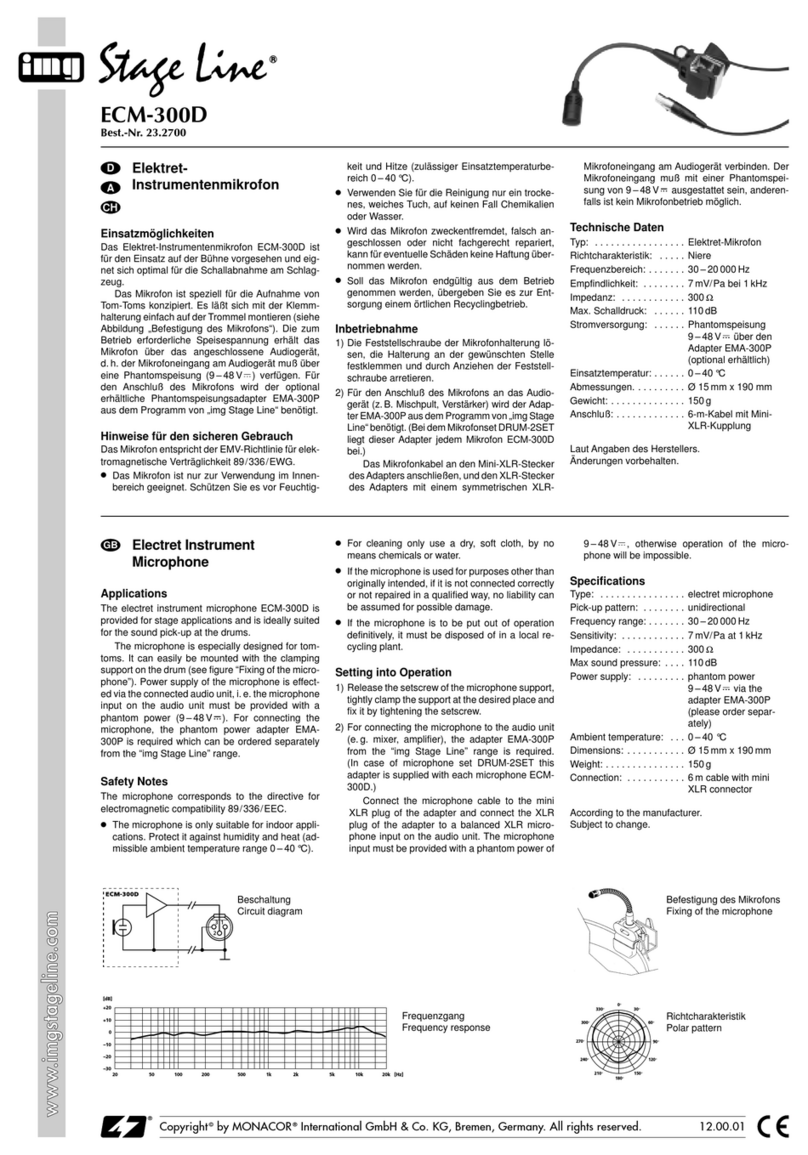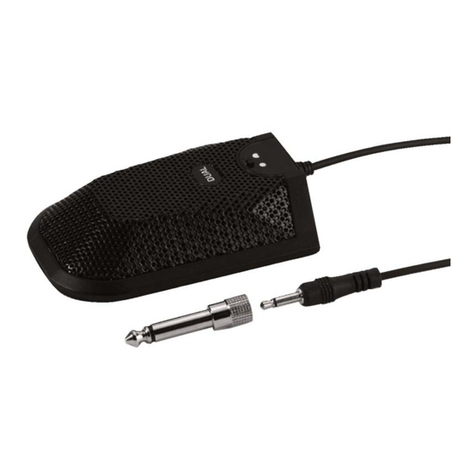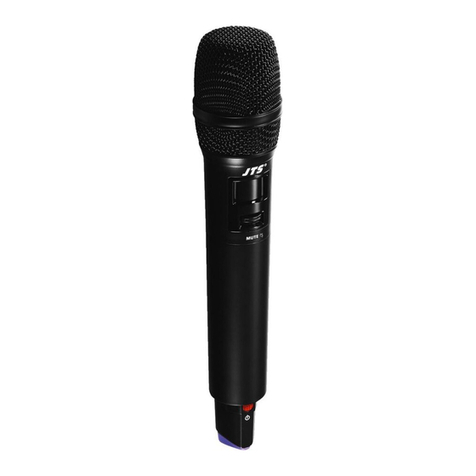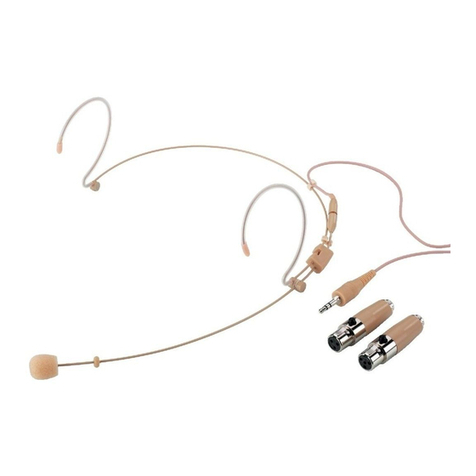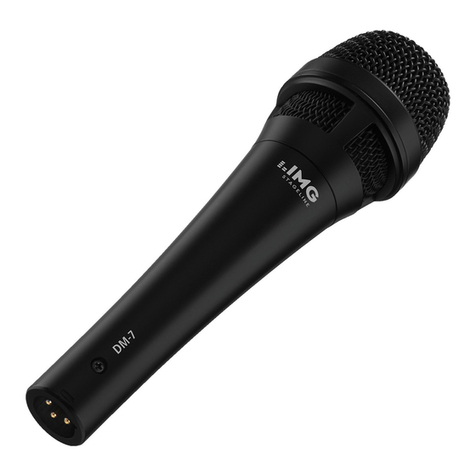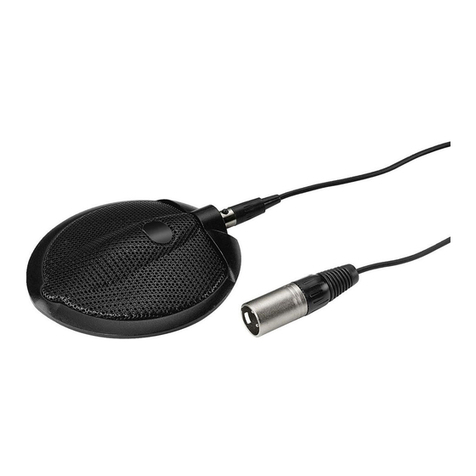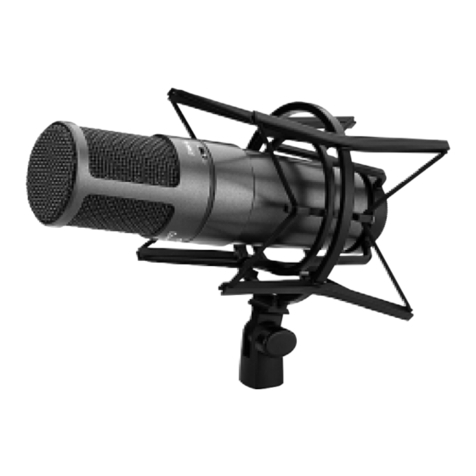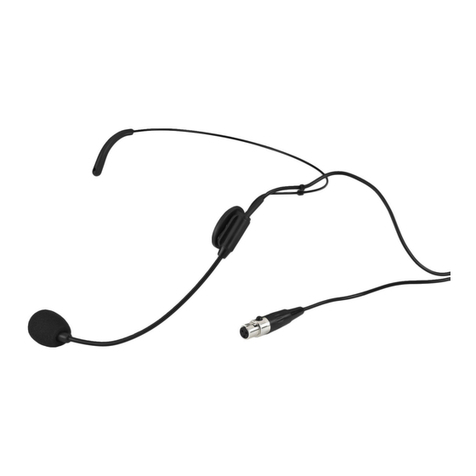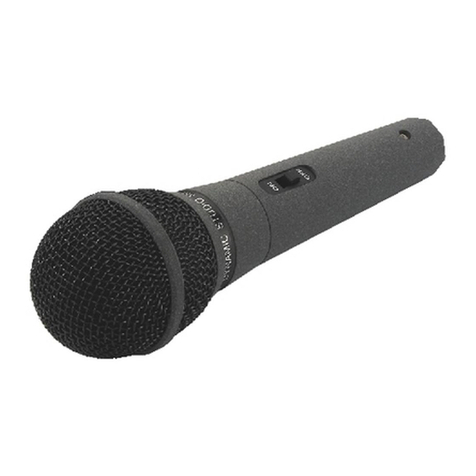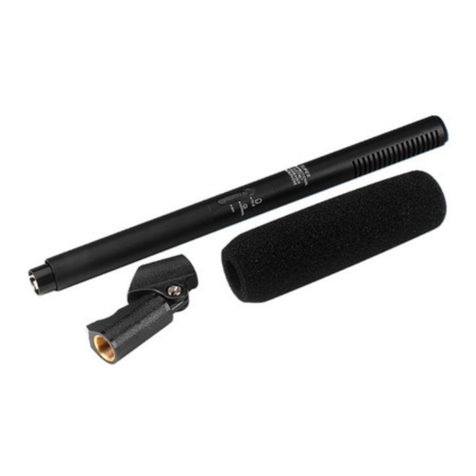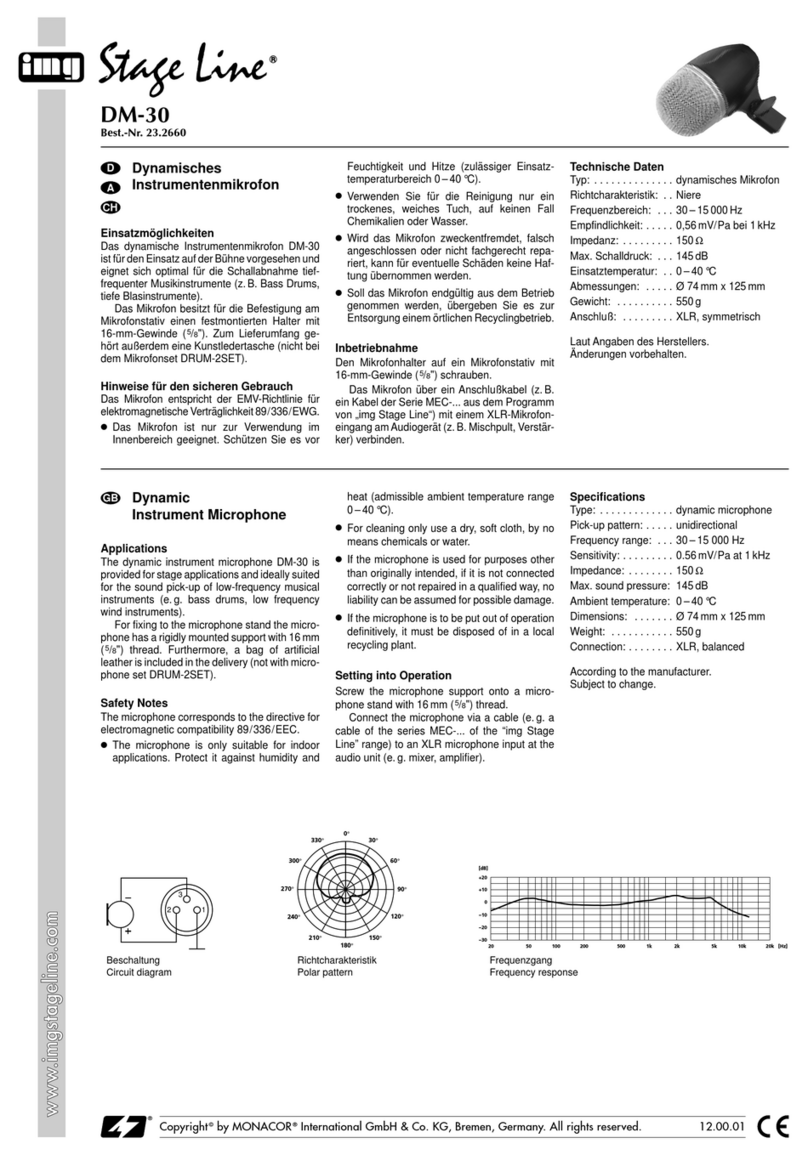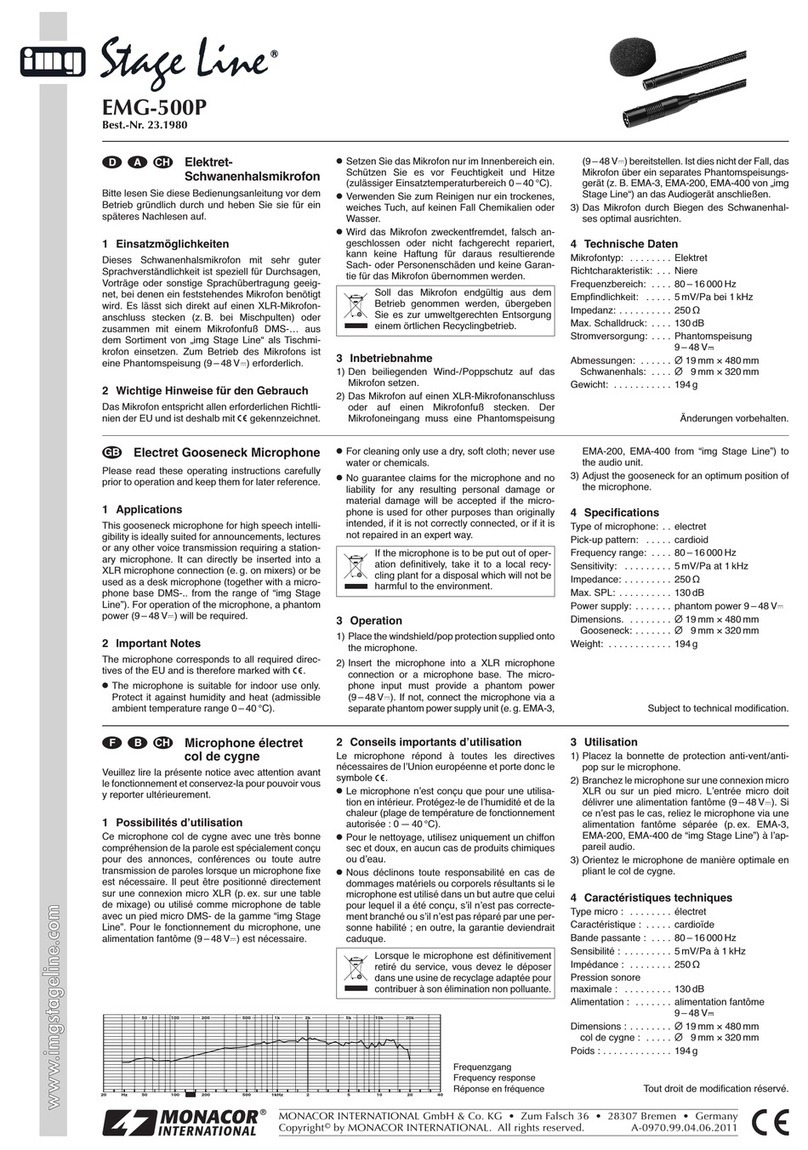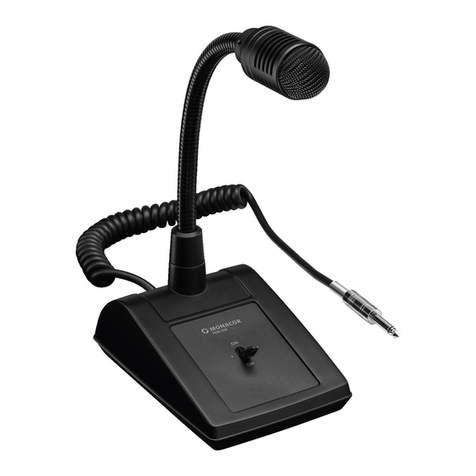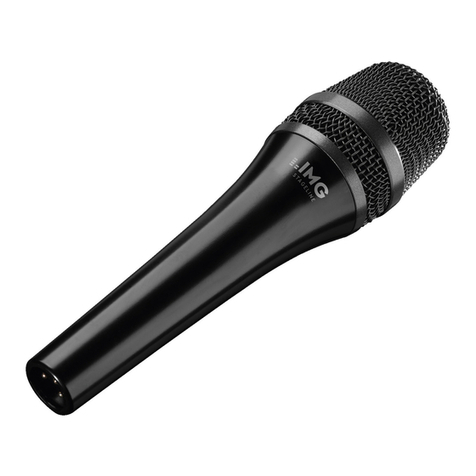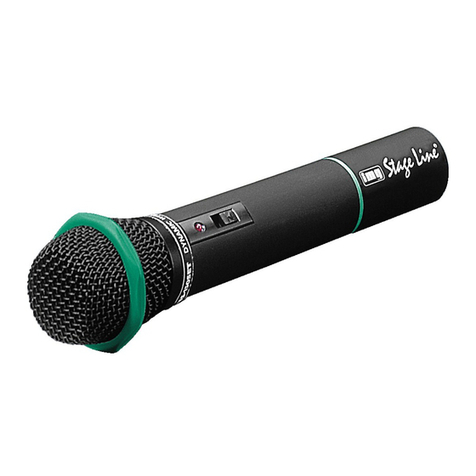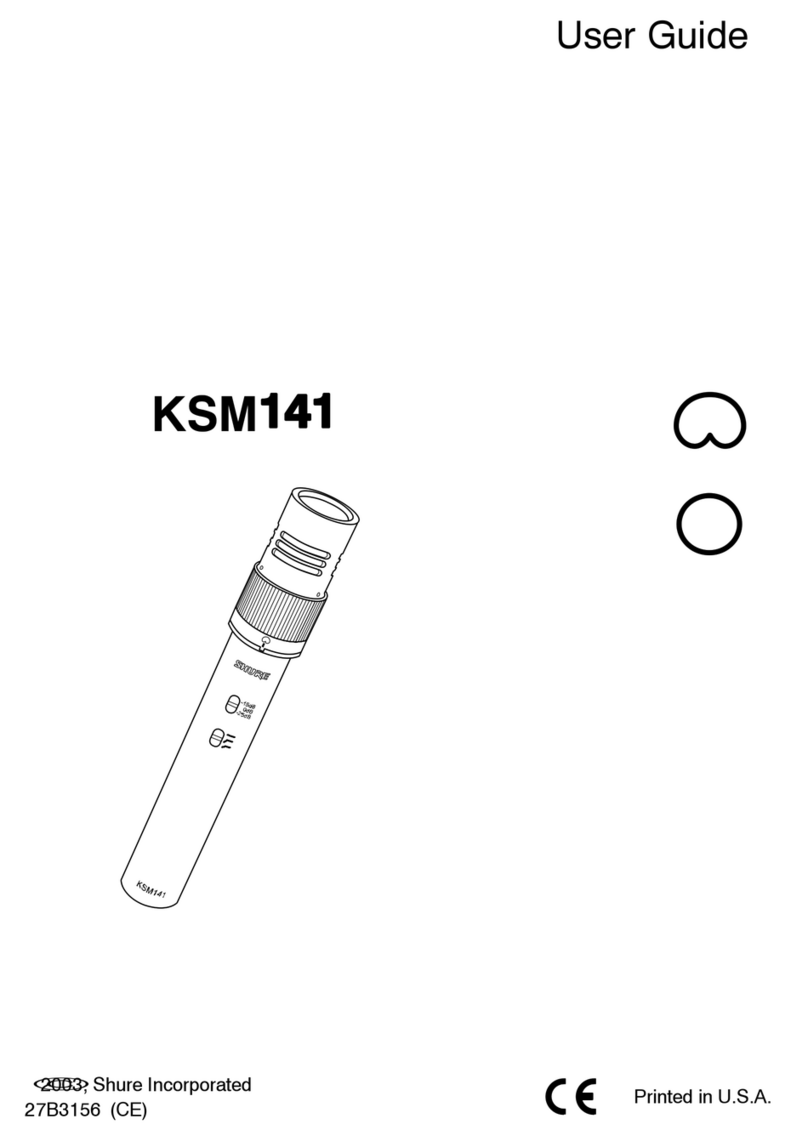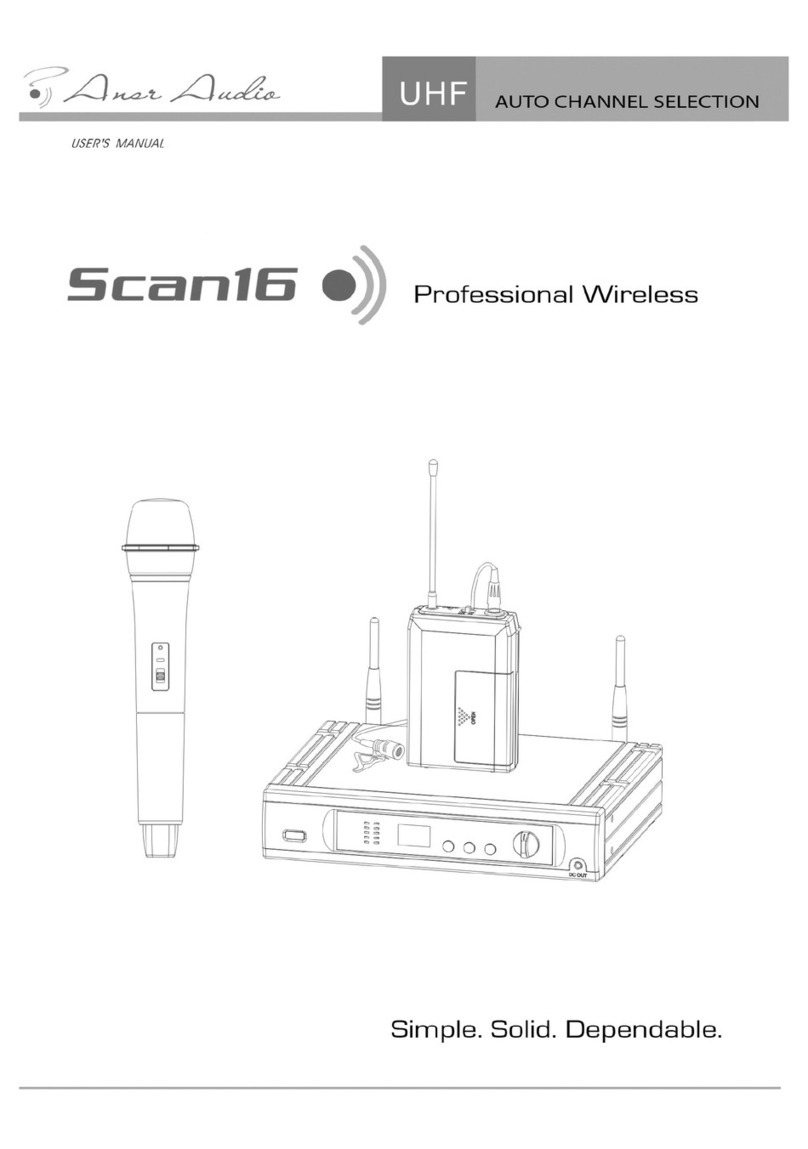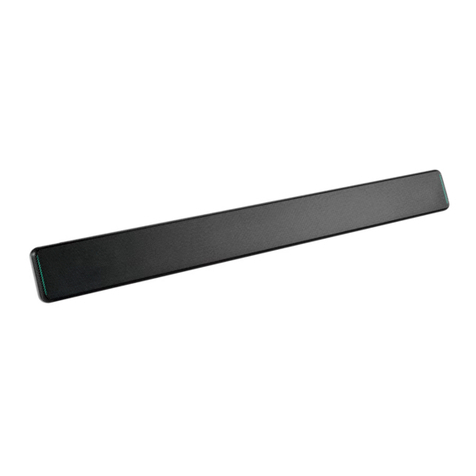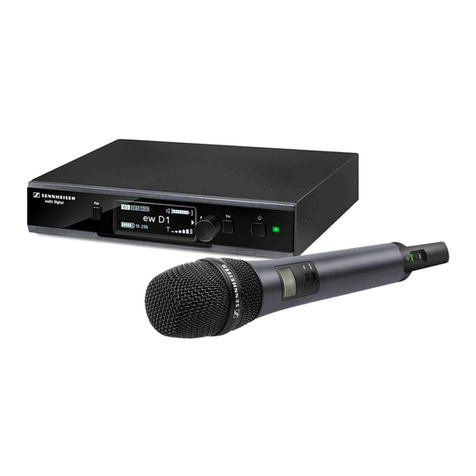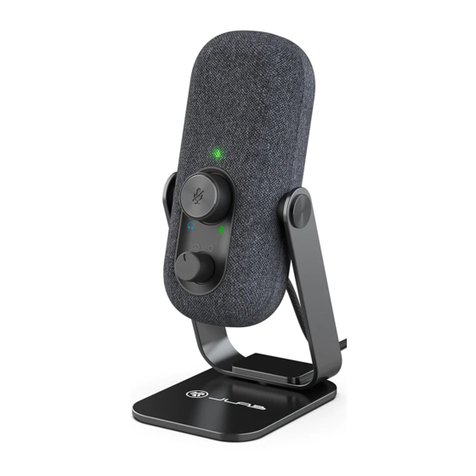ECM-80
Best.-Nr. 23.4220
wwwwww..iimmggssttaaggeelliinnee..ccoomm
Copyright©by MONACOR INTERNATIONAL GmbH & Co. KG, Bremen, Germany. All rights reserved. A-0507.99.01.11.2005
®
Micrófono electret de gran
membrana
Por favor, lea estas instrucciones atentamente
antes de su uso y guárdelas para usos posteriores.
1 Usos
El micrófono electret de gran membrana ECM-80
está indicado para recoger el sonido de instrumen-
tos musicales y para aplicaciones de sonido de
cantoy habla.Funcionaconuna alimentaciónphan-
tom de 48V y tiene un filtro low cut conmutable y un
interruptor de atenuación de 10dB. El micrófono se
entrega con un soporte para micrófono.
2 Notas importantes para el uso
Elmicrófonoresponde atodaslasnormativasreque-
ridas por la UE y por ello está marcado con .
●El micrófono sólo está indicado para un uso en
interior. Protéjalo de la humedad y del calor (tem-
peratura ambiente admisible: 0–40°C).
●Para limpiar use sólo un paño seco y suave, no
utilice productos químicos o agua.
●No se asumirá ninguna garantía para el micró-
fono ni se aceptará responsabilidad alguna en
caso de daños personales o materiales produci-
dos si el micrófono se usa con fines distintos a
aquel para el que fue fabricado, si no está co-
rrectamente conectado, o si no es reparado de
manera experta.
3 Montaje
1) Atornille el soporte para micrófono en un pie con
rosca de 16mm (5/8").
2) Desenrosque la anilla de rosca (4) de la parte
más baja del micrófono, ponga el micrófono en
la anilla (5) del soporte, y apriete fuerte la anilla
(ver figura 3).
3) Para ajustar el micrófono a la fuente de sonido,
suelte el tornillo (6) del soporte, ponga el micró-
fono como desee, y vuelva a apretar el tornillo.
4 Funcionamiento
1) Conecte el micrófono a través de un cable con
toma hembra XLR (p.ej. un cable de la serie
MEC de “img Stage Line”) a la entrada de un
micrófonode la unidadaudio utilizada(por ejem-
plo un mezclador). La entrada debe tener una
alimentación phantom de 48V. Si no es el caso,
conecte el micrófono a través de una unidad de
alimentación phantom externa (p.ej. la EMA-3
Si el micrófono es retirado del funcio-
namiento definitivamente, llévelo a un
centro de reciclaje para su eliminación
no contaminante para el medio am-
biente.
de “img Stage Line”) a la unidad audio. El LED
(1) se ilumina como una indicación de funcio-
namiento.
2) Para encender la atenuación de 10dB para
recoger las fuentes de sonido con alto nivel de
sonido (por ejemplo tambores, instrumentos de
viento de baja frecuencia), deslice el interruptor
más alto (2) a la posición “
-
10”.
3) Para encender el filtro low cut (pasa alto)
[atenuación de graves para compensar el efecto
de proximidad], deslice el interruptor más bajo
(3) hacia la posición .
5 Características técnicas
Tipo: . . . . . . . . . . . . . . supercardioide
Índice de frecuencia: . 20–16000Hz
Sensibilidad: . . . . . . . . 3mV/Pa a 1kHz
Impedancia: . . . . . . . . 150Ω
Presión sonora
máxima: . . . . . . . . . . . 130dB
Relación señal/ruido: 63dB
Alimentación: . . . . . . . alimentación phantom
48V
Conexión: . . . . . . . . . . XLR, simétrica
Dimensiones, peso: . . 52 x 41 x 165mm, 325g
Sujeto a modificaciones técnicas.
Wielkomembranowy
mikrofon pojemnościowy
Prosimy o uważne przeczytanie poniższej instru-
kcji przed użyciem urządzenia, oraz o zachowanie
tekstu do wglądu.
1Zastosowanie
Wielkomembranowy mikrofon pojemno ciowy
ECM-80 jest przeznaczony do zbierania dźwięków
z instrumentów muzycznych, znajduje również
zastosowanie przy rejestracji partii wokalnych i
komunikatów słownych. Urządzenie jest zasilane
napięciem fantomowym 48 V, jest wyposażone
w filtr dolnozaporowy i włącznik tłumieniowy
10 dB. W skład wyposażenia mikrofonu wchodzi
uchwyt mikrofonowy.
2Bezpieczeństwo użytkowania
Ponieważ urządzenie spełnia wymogi norm obo-
wiązujących w Unii Europejskiej, jest oznaczone
symbolem .
●Urządzenie przeznaczone jest do użytku tylko
wewnątrz pomieszczeń. Należy chronić je przed
działaniem wilgoci oraz wysokiej temperatury
(dopuszczalna temperatura otoczenia pracy to
0–40°C).
●Do czyszczenia urządzenia należy używać
suchej, miękkiej tkaniny; nie wolno używać
wody, ani chemicznych rodków czyszczących.
●Nie ponosi się odpowiedzialno ci za wynikłe
uszkodzenia sprzętu lub obrażenia użytkownika
w przypadku, gdy urządzenie jest wykorzy-
stywane w innych celach niż to się przewiduje,
je li jest niewła ciwie podłączone, lub poddane
nieautoryzowanej naprawie.
3Montaż
1) Należy przykręcić uchwyt mikrofonowy do sta-
tywu z gwintem 16 mm (5/8").
2) Należy odkręcić pier cień gwintowy (4) znajdu-
jący się w dolnej czę ci mikrofonu, następnie
umie cić mikrofon w pier cieniu uchwytu (5) i
dokręcić pier cień (zob. rysunek 3).
3) Aby ustawić mikrofon w optymalnym położeniu
w stosunku do źródła dźwięku, należy poluzo-
wać rubę (6) przy uchwycie, wyregulować
pozycję mikrofonu i dokręcić rubę.
4Przygotowanie do pracy
1) Należy podłączyć mikrofon do wej cia mikrofo-
nowego urządzenia audio (np. miksera) za
pomocą kabla z gniazdem nakablowym XLR
(np. kabel z serii MEC z oferty “img Stage
Line”). Na wej ciu musi być napięcie fanto-
mowe 48 V. Je li urządzenie audio nie dostar-
cza napięcia fantomowego, należy podłączyć
mikrofon do urządzenia audio przez
zewnętrzny zasilacz fantomowy (np. EMA-3 z
oferty “img Stage Line”). Wskaźnik LED (1) syg-
nalizuje pracę mikrofonu.
2) Aby włączyć tłumienie 10 dB przy zbieraniu
dźwięku o wysokim poziomie gło no ci (np.
perkusja, instrumenty dęte o małej częstot-
liwo ci), należy umie cić górny przełącznik (2)
w pozycji “
-
10”.
Je li urządzenie ma zostać ostatecznie
wycofane z użycia, należy przekazać je
do punktu utylizacji odpadów, aby uni-
knąć zanieczyszczenia rodowiska.
3) Aby włączyć filtr dolnozaporowy [tłumienie nis-
kich tonów w celu kompensacji efektu
blisko ci], należy umie cić dolny przełącznik
(3) w pozycji .
5ane techniczne
Charakterystyka: . . . . superkardioida
Pasmo przenoszenia: 20 – 16 000 Hz
Czuło ć: . . . . . . . . . . . 3 mV/Pa/1 kHz
Opór: . . . . . . . . . . . . . 150 Ω
Maks. SPL: . . . . . . . . . 130 dB
Stosunek S/N: . . . . . . 63 dB
Zasilanie: . . . . . . . . . . napięcie fantomowe
48 V
Połączenie: . . . . . . . . XLR, sym.
Wymiary, waga: . . . . . 52 x 41 x 165 mm, 325g
Z zastrzeżeniem do możliwych zmian.
E
PL

